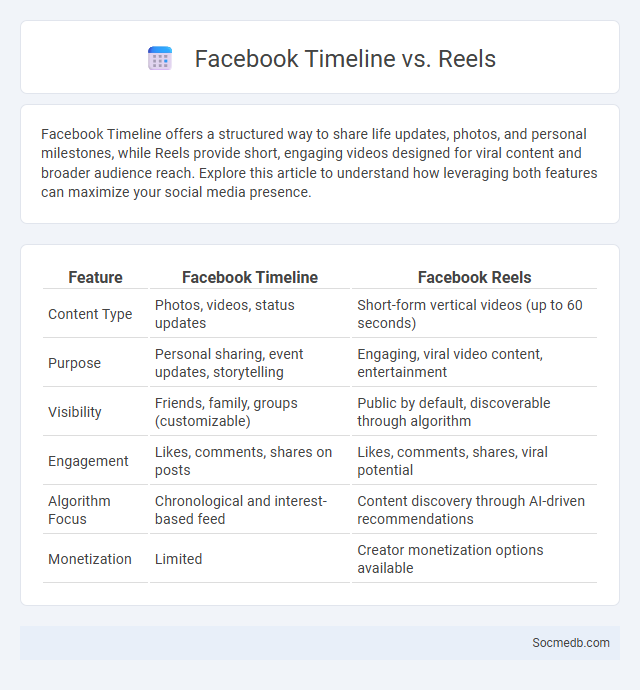
Photo illustration: Facebook Timeline vs Reels
Facebook Timeline offers a structured way to share life updates, photos, and personal milestones, while Reels provide short, engaging videos designed for viral content and broader audience reach. Explore this article to understand how leveraging both features can maximize your social media presence.
Table of Comparison
| Feature | Facebook Timeline | Facebook Reels |
|---|---|---|
| Content Type | Photos, videos, status updates | Short-form vertical videos (up to 60 seconds) |
| Purpose | Personal sharing, event updates, storytelling | Engaging, viral video content, entertainment |
| Visibility | Friends, family, groups (customizable) | Public by default, discoverable through algorithm |
| Engagement | Likes, comments, shares on posts | Likes, comments, shares, viral potential |
| Algorithm Focus | Chronological and interest-based feed | Content discovery through AI-driven recommendations |
| Monetization | Limited | Creator monetization options available |
Introduction to Facebook Features
Facebook offers a diverse range of features designed to enhance social interaction and content sharing, including News Feed, Messenger, Groups, and Marketplace. Its News Feed algorithm prioritizes personalized content to keep users engaged, while Groups facilitate community building around shared interests. The platform's Marketplace enables peer-to-peer buying and selling, integrating commerce seamlessly into social networking.
Overview of Facebook Timeline
Facebook Timeline organizes your digital life into a chronological, interactive feed showcasing posts, photos, and life events. It provides a comprehensive overview of your experiences, enabling friends to engage with your memories and updates easily. Managing privacy settings gives you control over who sees specific content, protecting Your online presence effectively.
Exploring Facebook Reels
Facebook Reels offers a dynamic platform for sharing short-form videos that engage millions of users worldwide. By leveraging trending audio, creative editing tools, and targeted hashtags, you can maximize visibility and grow your audience effectively. Algorithms prioritize content that sparks interaction, making your Reels a powerful tool for expanding brand presence on social media.
Key Differences Between Timeline and Reels
Timeline posts on social media primarily showcase static images or text updates that remain permanently visible, while Reels are short, engaging videos designed for quick consumption and high user interaction. Reels often benefit from algorithm-driven exposure, boosting your content's reach beyond your followers compared to the more static presence of timeline posts. Understanding these differences helps you tailor your strategy to maximize engagement and visibility on platforms like Instagram and Facebook.
User Engagement on Timeline vs Reels
User engagement on social media varies significantly between Timeline posts and Reels, with Reels often generating higher interaction rates due to their short, dynamic, and visually captivating format. Algorithms prioritize Reels to increase content visibility, boosting likes, comments, and shares compared to static Timeline updates. To maximize Your engagement metrics, leveraging Reels for timely trends and authentic storytelling proves more effective than solely relying on traditional Timeline posts.
Content Creation Strategies for Both Features
Content creation strategies for social media require leveraging the unique algorithms and formats of each platform's features, such as Stories and Feed posts, to maximize engagement and reach. You should prioritize high-quality visuals and concise messaging tailored to the target audience's preferences, incorporating trending hashtags and interactive elements like polls or questions to boost interaction. Consistent posting schedules combined with analytics monitoring enable continuous optimization of content performance across all features.
Audience Reach and Algorithm Insights
Maximizing your audience reach on social media requires understanding platform-specific algorithms that prioritize content engagement and relevance. Algorithms analyze user behavior like clicks, shares, and comments to deliver personalized feeds, impacting how many users see your posts. Tailoring your content to these algorithm insights enhances visibility and drives deeper audience connection.
Monetization Opportunities: Timeline vs Reels
Social media platforms offer varied monetization opportunities, with Timeline posts generating revenue primarily through branded content and sponsored ads targeting established followers. Reels provide higher engagement rates and enhanced visibility, attracting sponsorship deals and in-app shopping features that leverage viral short-form videos. Creators optimize earnings by blending both formats, using Timeline for consistent branding and Reels for rapid audience growth and real-time promotions.
Privacy and Control Settings Comparison
Social media platforms vary significantly in their privacy and control settings, influencing how users manage their personal data and online presence. Facebook offers detailed privacy controls, including options to limit profile visibility, customize ad preferences, and manage data sharing with third-party apps. In contrast, Instagram emphasizes simpler controls but has faced criticism for less transparent data handling, while Twitter provides granular settings for tweet visibility, direct message filtering, and location data management, allowing users to tailor their privacy experience.
Choosing the Best Feature for Your Goals
Selecting the best social media feature for your goals requires understanding the unique tools each platform offers, such as Instagram Stories for real-time engagement or LinkedIn Articles for professional networking. Tailoring content to features that maximize reach and interaction improves brand visibility and aligns with your marketing objectives. Prioritize features that directly support your target audience's preferences to boost engagement and conversion rates.
 socmedb.com
socmedb.com